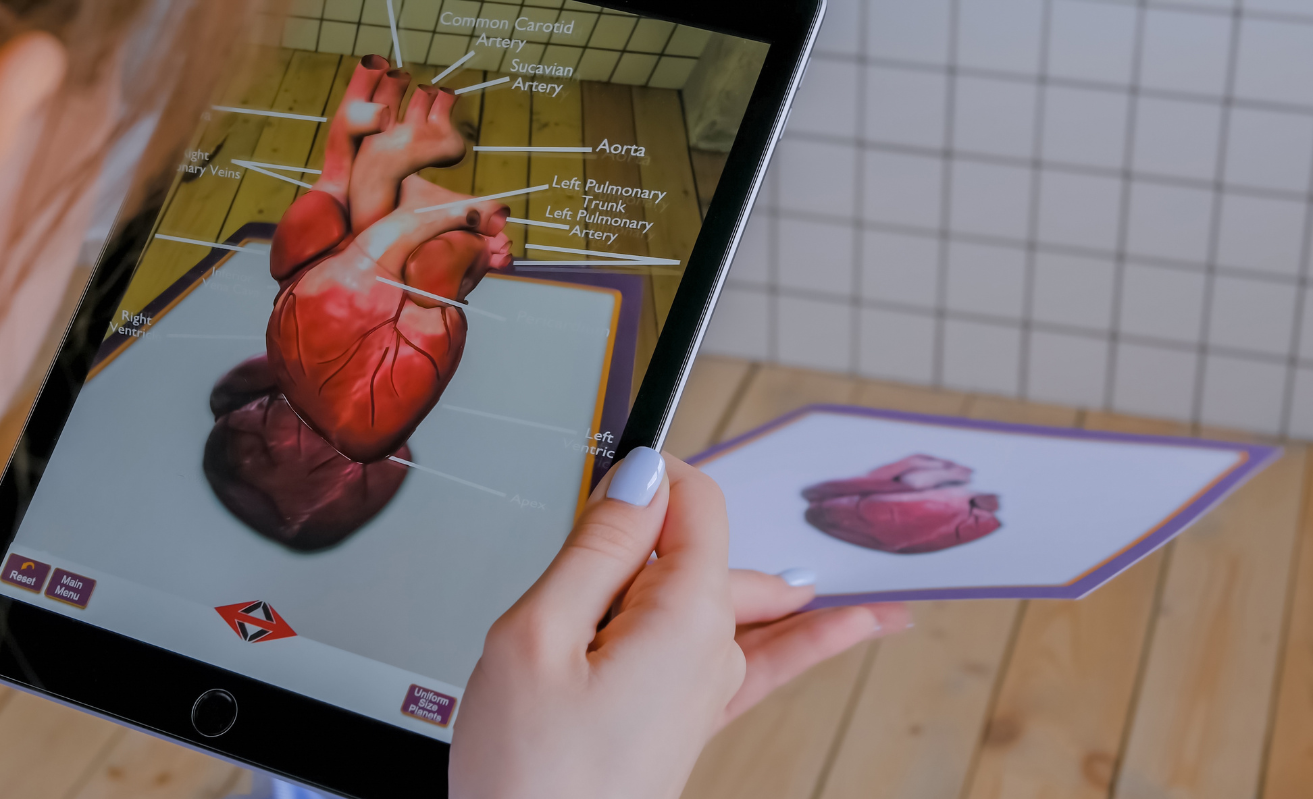With a few of our recent Augmented Reality (AR) projects coming close to launch, we sat down with Rob Giffin, our AR pro, to get his take on some of the common questions being asked.
What is AR?
AR is an interactive experience, bringing computer-generated content into real-world surroundings. The information is typically presented as 3D objects, but can also be text, images, or videos. The solutions can be interactive or simple animations. For example, you may point your phone camera at a photo of a patient, and the photo will be replaced with a video of the patient, bringing what would be a static image/poster to life.
Solutions can vary in complexity; some experiences show things as simple labels or information attached to real-world locations. Other solutions can attach AR experiences to an image, an object, a flat surface, or your own face.
What's the difference between AR and VR?
AR overlays digital information, such as text/image/video/3D objects in the real world whereas VR (Virtual Reality) replaces the real world with a fully immersive digital environment. This may be a 360 image/video or a full 3D environment allowing the user to interact with objects in the scene using VR controllers or their own hands.
How user friendly is AR?
There are a number of recent technological and social changes which have made AR more user friendly. For example, the introduction of web-based AR (AR which only requires your Web Browser and a mobile/tablet to view the AR experience) has made it more convenient than having to download an app.
You can still deliver AR experiences within a mobile app, and this works best for more complex experiences.
If you prioritise user experience, you can create AR tools which are easy to interact with, tell an interesting story, or provide useful information in a way which feels natural and anchored in the real world.

What opportunities are available with AR, is there a limit?
Many of the large tech companies are investing heavily in AR as they look for ways to move content away from a flat screen, and instead deliver in a more immersive and interactive way.
Meta (previously Facebook) is betting their entire company on AR/VR being the next big thing, and their consumer advertising includes a focus on healthcare being a key beneficiary.
There are a few minor limitations, mainly around complexity of the AR experience, due to the performance of the mobile / tablet. These will improve over time as the performance of these devices increases.
What do you need to be able to use AR?
Any mobile phone or tablet released in the last 5 years should be able to run Web AR experiences without any issues.
AR experiences with complex scenes will work better as an app-based experience. Apps can make better use of the mobile phone/tablet and give the potential to run on some older devices or provide a better experience on newer devices.
This experience is commonly viewed via a live video feed from your mobile phone or tablet. But it can also be viewed via AR Glasses, VR headset or MR (Mixed Reality) devices, which look very similar to VR Headsets but are designed for both AR and VR use.
Why would I use AR over any other channel to convey my information?
AR is a great way to deliver information in a memorable way, ensuring that the audience retains more of what they are seeing and reading. One way it does this is by delivering an experience that involves and engages multiple senses.
AR triggers multiple senses, ensuring that the information is more memorable than traditional formats. For example, imagine a 3D character projected in front of you talking about a condition or treatment. It’s so much more engaging and memorable than reading a leaflet.
AR is innovative. This alone captures interest and enthusiasm over a traditional leave piece or website. AR experiences can also be tailored to the viewer, for example, personalised links can be created and sent in emails.
These experiences can be launched from multiple existing platforms, such as a link/QR-Code on your brand website, email, banner ad, leave piece, poster, business card or many more. So, by using Web AR, you get instant impact from the user just scanning a QR-Code.

Is anyone else doing AR in our sector? How have other brands started to use AR?
There is a lot of interest around AR in healthcare at the moment.
From very high-end AR using Microsoft’s HoloLens to overlay patient information during surgery, to simple AR experiences used at conferences and exhibitions with talking head videos attached to images of patients. And everything in between.
We work with various pharma companies on different AR experiences, including learning and training, and bringing case and patient stories to life. Watch this space for case studies coming soon!
What do I need to get started on an AR solution?
If you have an idea, you think could work in AR, or if you want to hear our ideas, get in touch for a chat.
Or find out more about our new AR-details.


